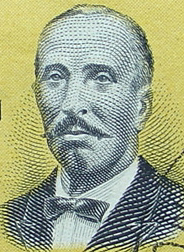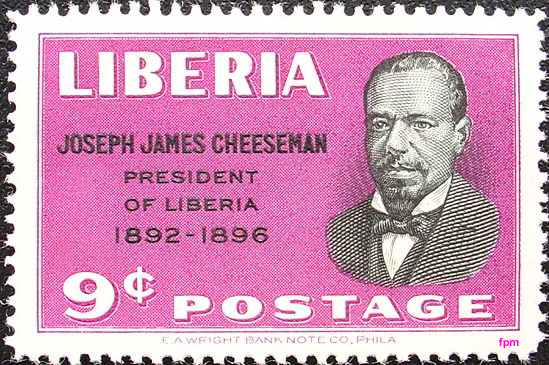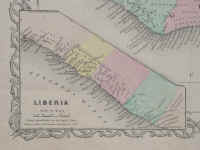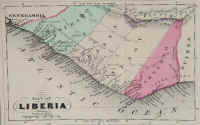|
President William David Coleman 1896 – 1900 |
|||
|
|
||||
|
William David Coleman was born in Fayette County, Kentucky, USA, in 1842. He came to Liberia at the age of eleven, with his widowed mother and three more family members, in 1853. They settled not far from Monrovia, in Clay-Ashland, in Montserrado County. Despite a poor youth - he even had to give up school because of lack of money – he rose to the highest position in the country. He thus followed the footsteps of J.J. Roberts, Liberia’s first President. As a young adolescent, William Coleman first became a carpenter, then master workman, farmer, and finally a successful trader – before he entered politics – while studying in the evenings and nights. He started his political career in 1877 as a member of the House of Representatives representing Montserrado County, rose to the position of Speaker of the House of Representatives and was elected senator for Montserrado County in 1879 - a position he held until 1892 when he became Vice President of the Republic of Liberia under President Cheeseman. The two men were twice re-elected. Both were ‘True Whigs’, i.e. member of the True Whig Party. |
|
|||
|
|
||||
|
President Coleman was particularly interested in education, he re-opened Liberia College assisted by Dr Edmond Wilmot Blyden. He also took measures that aimed to improve the country’s financial situation: he reorganised the customs department and installed bonded warehouses at the six ports of entry where since 1864 foreigners (traders) were allowed to undertake economic activities. The third cornerstone of his Administration was his Interior Policy. Coleman wanted by all means to increase the government’s presence in the interior since he was convinced that the future of Liberia depended on the exploitation of the resources of the interior. He established influence of the Liberian Government in the hinterland north-west of the Saint Paul River, beyond his home-town of Clay-Ashland. However, notably during his second term a growing number of Americo-Liberian fellow citizens disagreed with his interior policy. Differences sharpened over the years and an increasing number of once political friends sided with his opponents and put pressure on him to resign. Finally, President Coleman stepped down in December 1900 and thus became Liberia’s second president who resigned,
President Anthony Gardiner being the first one. Gardiner’s successor was
Alfred Russell who, like Coleman, hailed from Kentucky, USA. This coincidence is not a historical detail. It is very important and significant since it is illustrative of the fact that the Americo-Liberian political class consisted of a very small group of people. After his resignation William Coleman did not give up his political ambitions. In 1901, 1903 and 1905 he ran for the Presidency, on a ticket of the People’s Party, but was defeated each time. He died in his home-town of Clay-Ashland in 1908. Liberia’s perennial problems Since 1822 – the arrival of the first colonists – efforts to develop the country had been hindered by a number of factors. First there were the internal divisions within the group of colonists (far from homogeneous) separating ‘blacks’, including so-called Congo-people, from ‘mulattoes’ and other light-skin Americo-Liberians. The ‘Roye-incident’ is illustrative of this internal struggle for power. Secondly, there were external threats to the survival of a Colony or Republic governed by black people. These threats even gave rise to the proclamation of the Republic, in 1847, but are also illustrated by the greediness of European colonial powers during the ‘Scramble for Africa’ (see the loss of the Gallinas territory). Thirdly, there were threats from within that dated from the first days of colonisation: clashes and conflicts between the settlers (and later their descendants) with the tribal population living in the area claimed by the republic, i.e. the coastal counties and the vast Hinterland. The deeper the Liberian Government penetrated into the Hinterland and the more territory it claimed (if she would not do it European powers would claim it) the more resistance it met from the tribal population. Lastly, the overall constant problem was a financial one: keeping the foreigners under control resulted in the restrictive 1864 Ports of Entry Law (heralding the era of a Closed Door Policy). This Act outlawed international trade outside the main six ports, adding another reason for the inland and coastal tribal population to rise against the authority of the Monrovia based government. Whereas government revenue decreased as a result of the restrictive law, increased military spending to suppress the numerous revolts and wars added to the public deficit. This deteriorated an already precarious financial situation. Consequently, the Liberian Government faced financial bankruptcy at more than one occasion.
|
||||
|
Most conflicts and fights were over the ownership of land. Acquisition of land by the Government was sooner or later followed by conflicts. This was a logical consequence of the fact that, reportedly, almost all the land acquisitions by Government were forcible or fraudulent (Kappel: 1980; Akpan: 1986; Abasiattai: 1987). This finding is not surprising since traditional African customs did not allow for the transfer of traditional territory outside the tribal community. In general, during the 19th century, the Government imposed a kind of protectorate on the indigenous population of the Hinterland that it claimed to belong to the republic’s territory. Subsequently, the Monrovia Government intervened in indigenous affairs, with administrative measures or by military means - or both. A second important source of conflict had a more direct economic character, notably the competition for trading opportunities. In this field a specific reason was the trade in slaves. Some of the tribes were actively involved in the slave trade that brought them in conflict with the newly arrived freed slaves. However, a much lesser known immediate cause for military action of the central government against the tribal population were the many inter-tribal wars that were fought in the area claimed by the Republic. Understandably, this motive is closely connected to the government’s at times imposed protectorate over the Hinterland and subsequent intervention in indigenous affairs. President Coleman’s political misfortune occurred following his intervention in one of these inter-tribal wars.
President Coleman’s resignation and succession The real reasons of Coleman’s political departure
Abasiattai, Monday B., ‘Resistance of the African Peoples of Liberia’, in: Liberia Forum, Vol. 3, nr. 4, 1987, pp.53 – 71 (Liberia Working Group, Bremen, 1987). Akpan, Monday B., ‘’ The practice of indirect rule in Liberia: The Laying of the Foundations, 1922 – 1915’, in: Hinzen, Eckhard, and Kappel, Robert (eds), ‘Dependence, Underdevelopment and Persistent Conflict – On the Political Economy of Liberia’, pp. 57 – 168 (Bremen, 1980). Akpan, Monday B., ‘Gola Resistance to Liberian “Rule” in the Nineteenth Century, 1835-1905’, in: Liberia Forum, Vol. I, nr. 1, 1985, pp. 5 – 27 (Liberia Working Group, Bremen, 1985). d’Azevedo, Warren L., ‘A Tribal Reaction to Nationalism’, Part 1, in: Liberian Studies Journal, Vol. I, nr. 2, 1969, pp. 1 – 22 (Greencastle, 1969). d’Azevedo, Warren L., ‘A Tribal Reaction to Nationalism’, Part 2, in: Liberian Studies Journal, Vol. II, nr. 1, 1969, pp. 43 - 65 (Greencastle, 1969). d’Azevedo, Warren L., ‘A Tribal Reaction to Nationalism’, Part 3, in: Liberian Studies Journal, Vol. II, nr. 2, 1970, pp. 99 – 117 (Greencastle, 1970). d’Azevedo, Warren L., ‘A Tribal Reaction to Nationalism’, Part 4, in: Liberian Studies Journal, Vol. III, nr. 1, 1971, pp. 1 – 21 (Greencastle, 1971). Buell, Raymond Leslie, ‘The Native Problem in Africa’, 2 vols. (Harvard, 1928; London, 1965). Buell, Raymond Leslie, ‘Liberia: A Century of Survival 1947 – 1947’(Philadelphia, 1947; New York, 1969). Campbell, Penelope, ‘Maryland in Africa, the Maryland State Colonization Society 1831 – 1857’(Chicago, London, 1971). Cassell, C. Abayomi, ‘Liberia: History of the First African Republic’ (New York, 1970). Dunn, D. Elwood, and Holsoe, Svend E., ‘Historical Dictionary of Liberia’, (Metuchen, London, 1985). Henries, Doris and Richard, ‘Liberia – the West African Republic’ (New York, n.d.). Huberich, Charles H., ‘The Political and Legislative History of Liberia’, 2 vols. (New York, 1947). Kappel, Robert, ‘Resistance of the Liberian People – Problems of the Ignored Facts, in: Hinzen, Eckhard, and Kappel, Robert (eds), ‘Dependence, Underdevelopment and Persistent Conflict – On the Political Economy of Liberia’, pp. 169 - 197 (Bremen, 1980). Kraaij, van der, Fred, ‘The Open Door Policy of Liberia – An Economic History of Modern Liberia’, 2 vols. (Bremen, 1983). Richardson, Nathaniel R., ‘Liberia’s Past and Present’ (London, 1959). Wreh, Tuan, ‘The Love of Liberty … The Rule of President William V.S. Tubman in Liberia 1944 – 1971’ (London, 1976).
|
Two maps
showing the gradual acquisition of land:
1855 J.H. Colton
|
|||
| © fpm van der kraaij | ||||




